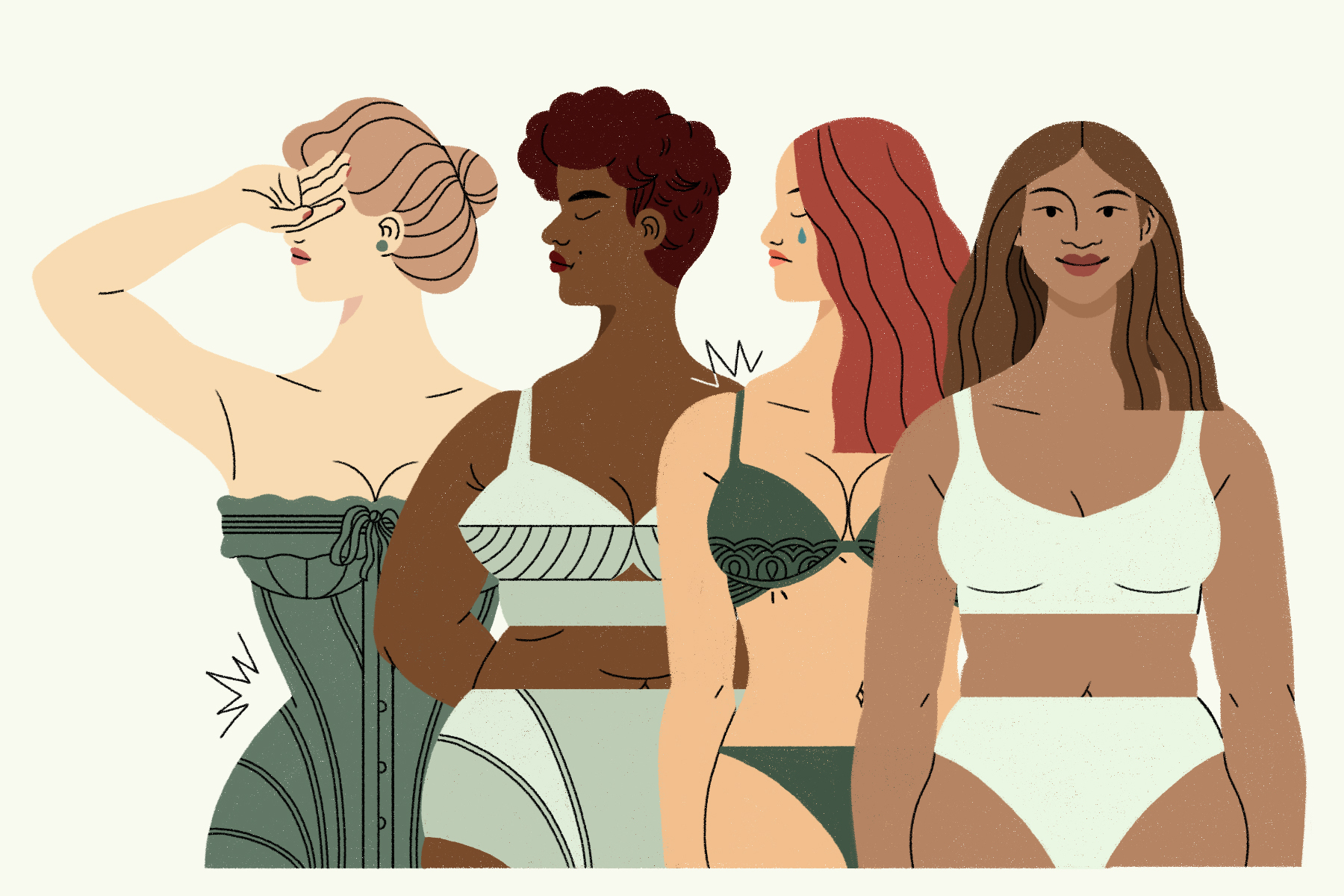In the past two years, sales of jeans, high heels, and formalwear have plummeted. The COVID-19 pandemic brought with it a new uniform, and anything uncomfortable or flashy seemed destined for a quick death. So it’s no wonder people began to speculate that the bra—the most annoying item in many women’s wardrobes, according to one survey—was fast-tracked for extinction. “Bras are a Curse!” proclaimed the Guardian; “Bra Furlough Extended,” wrote feminist satire publication Reductress. Meanwhile, the Seattle Times declared that bras, along with “hard pants” and business casual, may not return to people’s wardrobes post-COVID-19. After all, an ill-fitting bra can deflate your self-esteem—like a pair of jeans that cinches and expands in all the wrong places. That’s in addition to the aches and irritation often caused when it doesn’t sit quite right. Why suffer through all this when you could simply rid your underwear drawer of prodding underwire and suffocating strapless devices altogether?
Listen to an audio version of this story
For more audio from The Walrus, subscribe to AMI-audio podcasts on iTunes.
But trend forecasters and news sites couldn’t have been more wrong about the anticipated twenty-first-century bra burnings. Instead of getting rid of bras altogether, women were reshaping them into what they needed—literally. On TikTok, users hacked apart their old padded push-ups with scissors to turn them into lacy bralettes. Watching the videos felt cathartic. At long last, the cages designed to squish our breasts into unpleasant contortions were being retired in favour of something softer and less constricting.
At the same time, many lingerie companies distanced themselves from the styles worn by Victoria’s Secret Angels of the past and focused on promoting comfort—a shift that was already underway prepandemic but gained even more momentum over the past two years. Vogue’s best bras of 2021 list touts bralettes and sports bras made of cashmere, lace, and cotton. At Cosabella, an Italian lingerie company, bralettes now make up half of sales, according to an interview in the New York Times. According to a lingerie market trends report, the industry is projected to grow nearly 8 percent by 2026—which would explain the crop of independent lingerie brands that have been thriving since the onset of the pandemic.
Fashion has, for centuries, adapted to a changing world, and major trends often correspond with significant historical events. But, in the instance of the bra, it feels like we’ve reached a turning point: one that isn’t just about style but instead asks us to reconsider the purpose of our undergarments altogether. “There’s been this unwritten rule that our breasts need to be strapped up and held up and we have to pretend we don’t have nipples,” Chloé Julian, a former designer at Rihanna’s Savage X Fenty, told the New York Times last year. “We’re starting to question that.”
While each iteration of the bra has been slightly different, nearly every redesign has been just as much about achieving a certain shape—dictated by the male gaze—as it has been about functionality. In ancient Greece, cloth was wrapped around the chest and fixed in position to divert attention to the hips (and a woman’s childbearing potential), according to The Exploress podcast. By the twelfth century, it was the opposite. In Hens: Why Women Are Different, Carl Fors references a “courtesy manual” that discouraged women from covering their chests, instead advising that their dresses should “be low cut so that everyone can gaze and gape.” Beginning in the sixteenth century, corsets helped women achieve what was considered the ideal figure, essentially that of a Renaissance Barbie. Later, as tight-laced corsets became more à la mode, waists were cinched in and breasts thrust upward until they resembled beach balls.
With each passing era, the design of the bra inched closer to the modern-day standard. In 1914, the first US bra patent was granted to Mary Phelps Jacob (later known as Caresse Crosby). Jacob, who was in her early twenties, was a New York socialite who spent her nights out in Manhattan. At the time, evening dresses made from silk and satin, with low-cut bodices and empire waistlines, were common among upper class women, but most corsets—given their bulky shape—looked awkward under the fabrics. Jacob’s solution was a set of pocket handkerchiefs stitched together with a pink ribbon. It was “delicious,” she recalled. “I could move more freely, a nearly naked feeling.”
Since corsets had dominated the market for nearly 400 years, the brassiere took a while to catch on. But that began to change with the onset of the First World War. As masses of women joined the workforce, serving overseas as nurses, mechanics, switchboard operators, and truck drivers, and at home as farmers and factory workers, they needed an everyday undergarment that could better serve their needs. Even those who stayed home didn’t have much of a choice. Since the US needed metal to create ammunition and other military supplies, the chairman of the US War Industries Board asked women to stop buying corsets altogether. According to NPR, the plea saved 28,000 tons of steel—enough to build at least one battleship.
Perhaps unsurprisingly, when the war ended, no one missed the corset, and by the 1940s, brassieres were declared a “vital necessity.” In Uplift: The Bra in America, researchers conducted an informal survey, asking women over fifty why they wore their first bra. The most common answers among respondents were the desire to achieve a certain look, peer pressure, and the need for support. “Only a small number of women mentioned comfort as an inducement,” the survey found.
The idea that bras weren’t supposed to be comfortable would stick around for the next seventy-five years, making way for contraptions like the torpedo bra. Touted by Hollywood stars and pinup girls of the era, its padding and cone-shaped cups mimicked the voluptuous busts then prominent on the big screen. Trying to make breasts appear bigger became a popular feature in lingerie design throughout the following decades, from the inflatable bras of the ’50s (“perfection without detection,” one advert claimed) to the push-ups made famous by WonderBra.
Even in the past few years, some companies have still marketed lingerie with the underlying message that it should be worn for someone else. Just look at the ghosts of holiday advertisements past: the tagline of a 2012 Victoria’s Secret commercial, featuring a chesty model in a lacy pink push-up bra carelessly tossing rose petals through the air, was “This Valentine’s Day, say it with sexy.” Meanwhile, a Boux Avenue ad suggested using its lingerie to “melt someone’s heart this Christmas.”
For years, women have used the bra—or lack thereof—as a political tool: bralessness was a form of resistance, of freedom, and of self-acceptance. But this new era, which embraces the natural shapes and sizes of breasts instead of trying to mould them into something different, can embody those same things. Colleen Hill, the curator of costume and accessories at New York’s The Museum at the Fashion Institute of Technology and the author of Exposed: A History of Lingerie, tells me that the trend coincides with the body positivity movement. As the definition of beauty has expanded over the past decade to include more than just thin white models, the styles of lingerie have expanded too. “There have been so many shifts in our priorities over the past few years,” she says. “Embracing who we are, how our bodies look, not worrying what others think of us and making ourselves feel comfortable has been a priority. I think lingerie plays a very important role in that.”
Those ideas are reflected in how bras are marketed today. According to Christina Remenyi, the founder of Toronto-based lingerie brand Fortnight, in the mid-2000s, most big box retailers had narrow size ranges for ease of commerce. “Marketing was very much driven by sex and the male gaze,” she wrote in an email. “But women want to see marketing that reflects themselves.”
Over the past few years, companies big and small have adapted that formula by offering a wider range of sizes and showcasing stretch marks, belly rolls, and breasts of all shapes. Aerie, the sister brand of American Eagle, has built a marketing strategy around inclusivity. Since 2014, it has stopped retouching photos of its models and has launched a series of campaigns around body positivity and self-love, including its “Don’t Change You. Change Your Bra!” program, a partnership with the National Eating Disorders Association that provided store associates with training on how to create judgment-free spaces within its stores. When Rihanna debuted Savage X Fenty, in 2018, she took a similar approach, telling the New York Times that her concept was about “women being celebrated in all forms and all body types and all races and cultures.” While popular companies like La Senza offer only sizes up to DD, Fenty bras are available from A to H cups. Other brands now make nude undergarments in a wider range of skin tones to cater to those who, until recently, had been largely excluded.
Even though the definition of what a lingerie-clad body should look like has expanded, unlearning beauty ideals—and the trends we adopt alongside them—is a long, tedious process. The pandemic, however, has made space for us to rethink them. Emilie Hajek, who in 2018 founded Stay Soft—a Montreal-based lingerie brand “for those who don’t like bras”—says spending more time at home means that pressure to present in a certain way is largely gone, opening up new avenues for self- expression.
“People realized they could wear something outside of their norm because they weren’t worried about being judged or scrutinized,” she says. “The bralette blossomed in that space because of the feeling of freedom that it brings. When we start wearing things that embrace our natural shape, we’re ourselves by ourselves.”
My own underwear drawer used to be filled with an assortment of seemingly sexy push-ups and bustiers, but over the past two years, as my tolerance for discomfort waned, I got rid of them all.
These days, whenever I do put on a bra—usually a bralette—it’s because I want to, not because I feel like I have to. Lingerie is just as much a part of my wardrobe as any other accessory, and what I wear changes based on how I want to feel: whether that’s sexy, comfortable, or completely free.
I can’t imagine a world where I’ll return to the daily misery that accompanies wearing underwire, but according to Hill, I probably won’t have to. Fashion is a cycle, and while changes in trends are inevitable, she predicts that what will remain are options. “I think it will continue to be acceptable to wear whatever you want, whether that’s a bralette, something unstructured and simple, or something that’s completely other,” she says. “But I’m hoping what we will retain are these ideas around positivity and, most importantly, dressing for ourselves.”
Correction February 24, 2022: An earlier version of this piece referenced an NPR article which stated that 28,000 pounds of steel—enough to build two battleships—were saved after women were asked to stop buying corsets during the First World War. In fact, 28,000 tons of steel were saved, enough to build at least one battleship. The Walrus regrets the errors.





